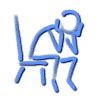|
~~Electroconvulsive Shock Treatment~~
|
Willerman, & Cohen (1990). Psychopathology New York: McGraw-Hill, Inc.
ECT was first introduced in Italy in 1938 by Cerletti and Bini,
with widespread use in the United States almost from the beginning.
Much controversy has surrounded its application,
in part because it was originally called electroshock therapy,
but also because the violent seizures produced were
quite frightening. The early history of ECT is
lamentably laden with excess and misuse.
Patients were given too many treatments, electrical
currents were often poorly controlled, oxygenation
and sedation were not employed, and the convulsion
itself was frightening. (p.626)
Nowadays the oxygenated patient is sedated and a
paralysis-inducing muscle relaxant is injected.
Electrodes placed bilaterally or unilaterally at
various locations around the skull permit an
electric current to be passed for about a half second.
In the absence of muscle relaxants, this immediately
produces a grand mal convulsion consisting of a tonic
phase in which the patient stiffesn for about ten
seconds followed by a clonic phase composed of
alternating stiffenings and relaxations lasting for
another forty seconds.
Since the introduction of muscle relaxants to prevent
bone fractures, the convulsive manifestations of the
seizure are hardly apparent, though there is a slight
flexion of the feet. After the seizure has stopped a
short period of anoxia occurs because spontaneous
breathing is temporarily lost - hence the oxygen
respirator. Early versions of ECT did not administer
oxygen, and it is quite possible that unnecessary
brain damage sometimes resulted.
The patient regains consciousness in a few minutes
but is in a clouded state for about a half hour,
perhaps with nausea and headaches. If treatment is on an
outpatient basis, patients can be taken home after an hour.
Patients typically undergo a seriouses of thrice-weekly
treatments lasting two to four weeks. (p. 626-7)
Effectiveness: The short-term efficacy of ECT
for depression is not in much dispute. More than
80 percent of depressed drug-nonresponders show
rapid mood improvements with ECT... ECT increases
hypothalamic activation for selected hormones, and
limbic arousal may be important in producing
mood changes. However, the fact that the treatment
excites so many brain areas makes it difficult to
tell how the treatment works. (p.627)
Adverse Effects: Assertions that ECT causes
brain damage and memory impairments are probably
the main reason that ECT is typically a treatment
of last resort. (p.627)
Acute EEG slowing and psychological impairments
suggest that ECT produces an organic delirium for
several days with perahsp minor signs of memory
loss for as long as three months. Initially,
patients show confusion, disorientation, and
amnesia for the events around the time of the ECT.
While the confusion and disorientation rapidly
dissipate, some amnesia may remain. It is not the
durable loss of memory for the ECT itself that
sustains the controversy, but the question of
more generalized memory loss.
Most of the evidence for the permanent brain
damage argument stems from evocative case histories
and uncontrolled studies. Controlled studies reveal
no evidence of sustained or serious memory impairment
aside from the events... the depressed are prone
to exaggerate real or imagined deficiencies. These
defenders are in an awkward position, however,
because it is impossible to prove that something
does not cause brain damage; after all, a more
sensitive test might reveal a previously
undetected impairment. (p.628)
You might also be interested in checking out
a more detailed and descriptive page on
shock treatment,
brain damage and memory loss.
|
| |




